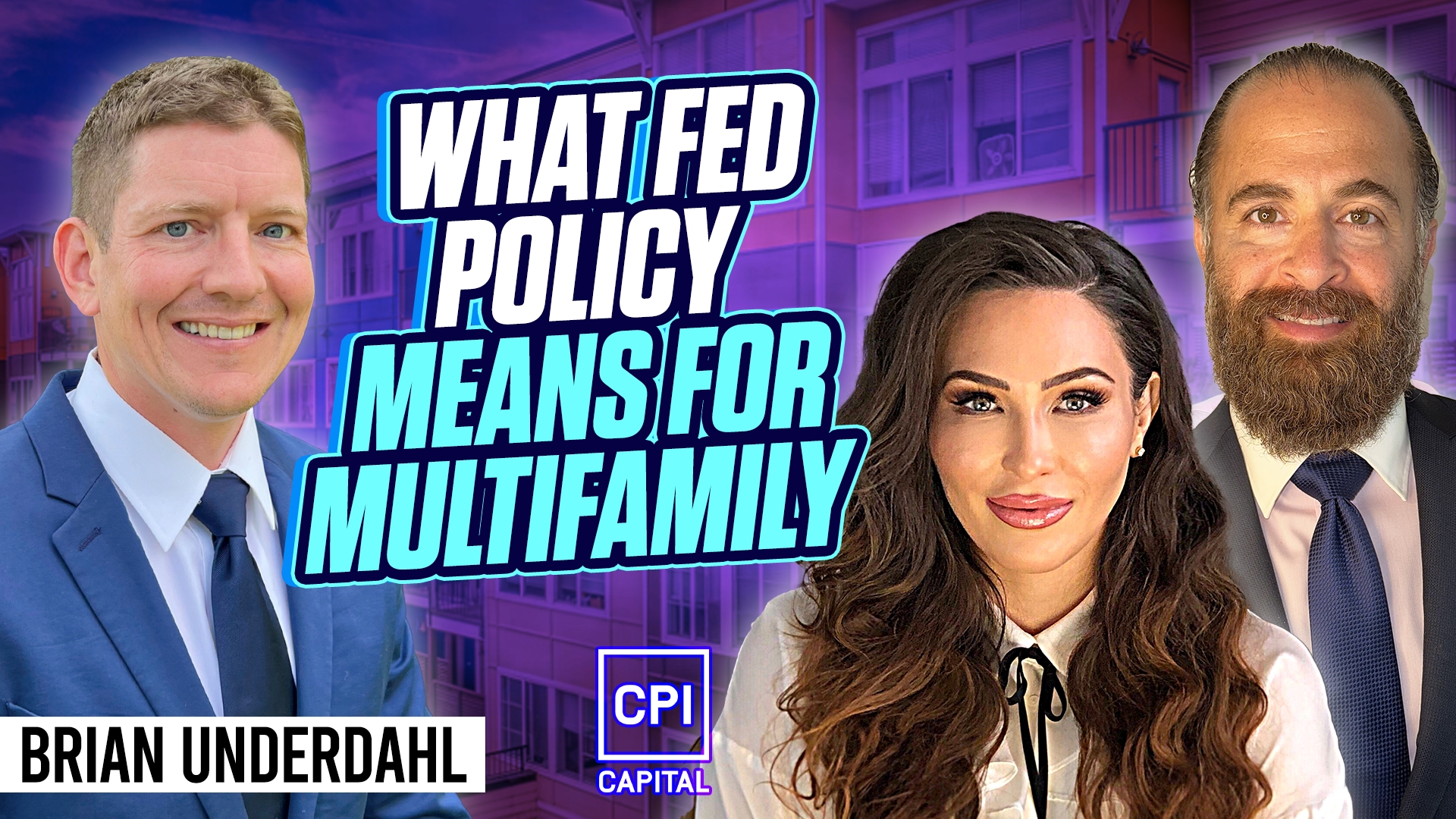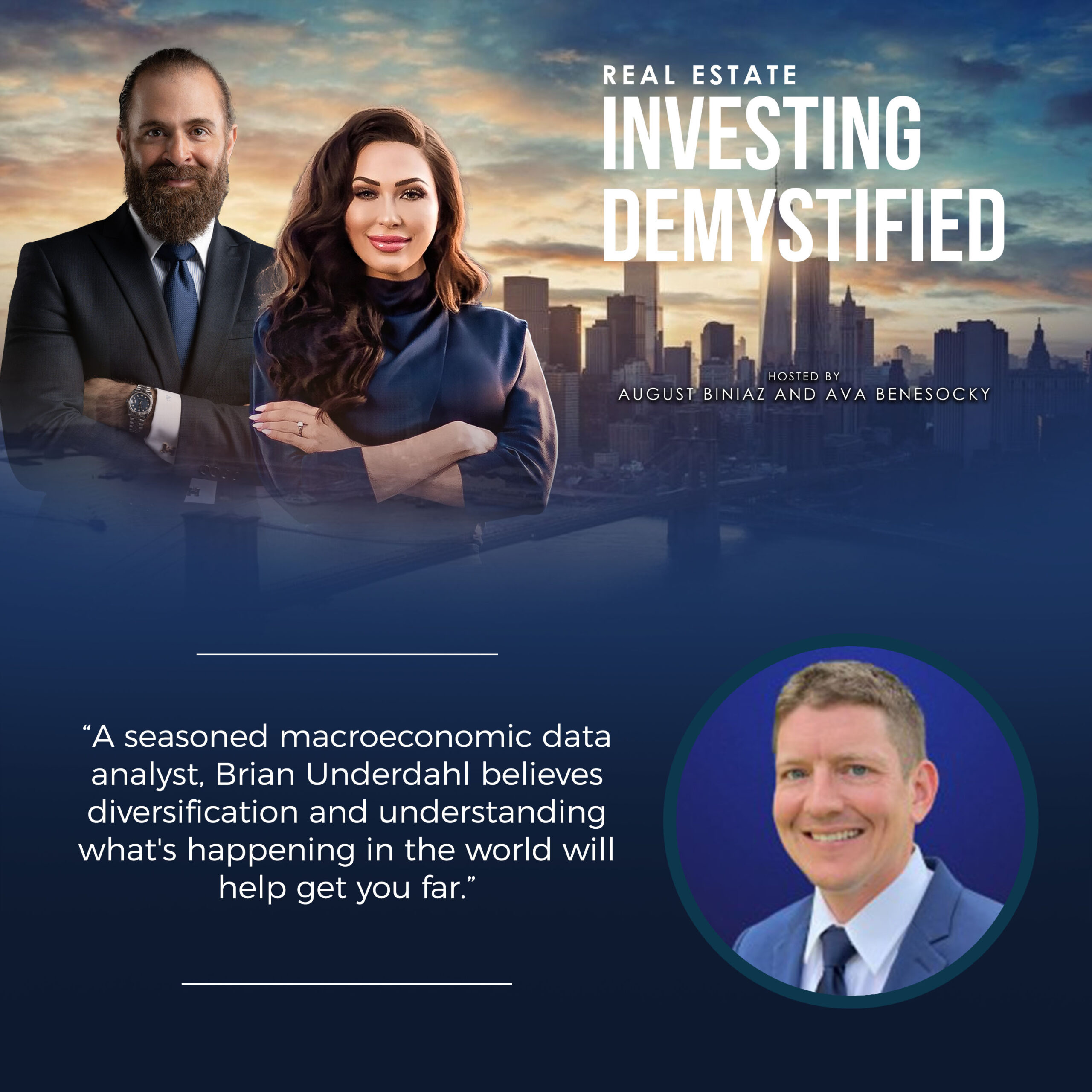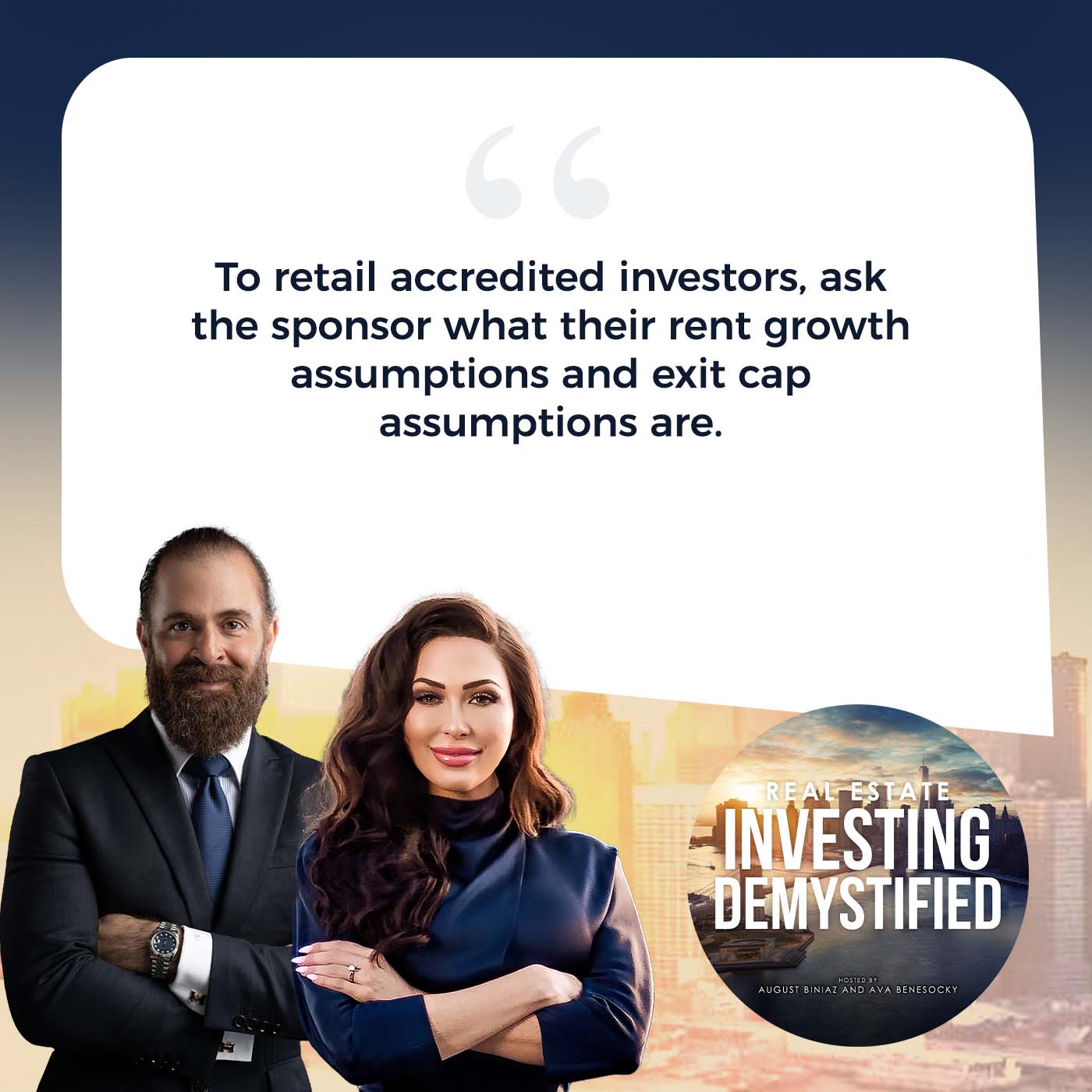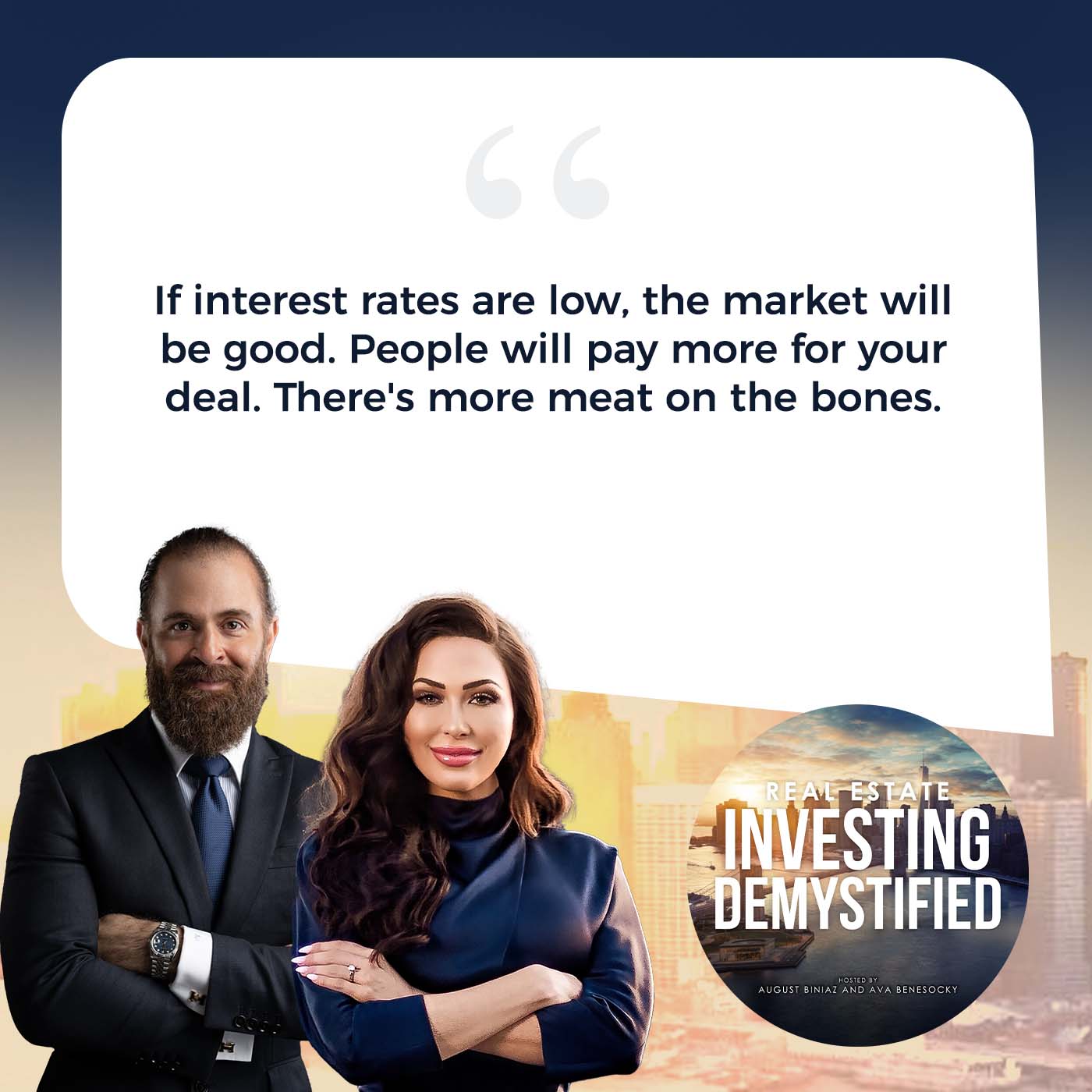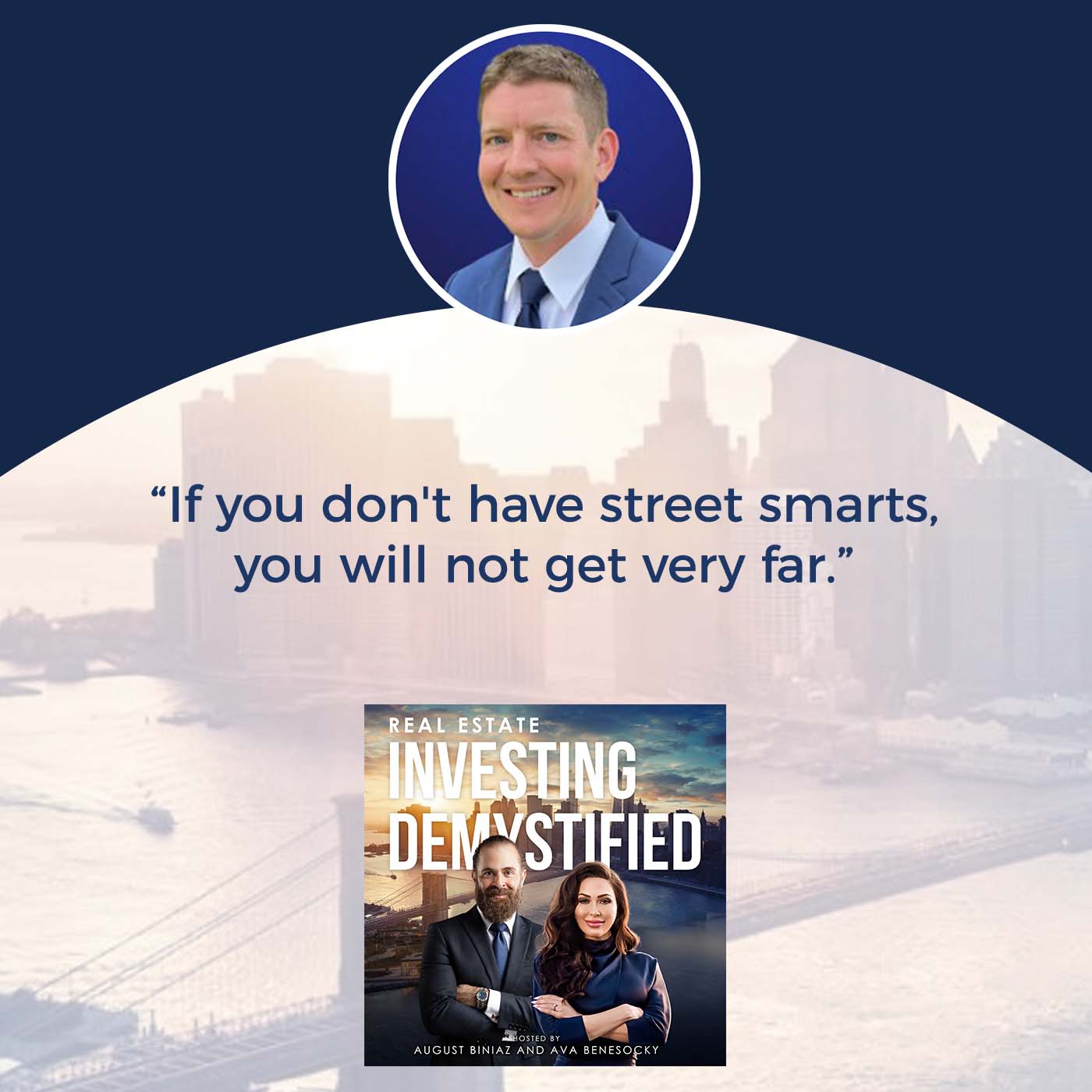Brian Underdahl, Chief Analytics Officer for Nuvo Capital Partners, joins Ava Benesocky and August Biniaz on the show today to discuss what Fed policy means for multifamily investments. Brian shares his journey from a sales career to real estate investing. He explains what Nuvo Capital Partners does, which is providing rescue capital for multifamily deals that need additional capital to execute the business plan. This episode provides deep insights into the intersections of Fed policy, economic trends, and the multifamily real estate market, making it a must-listen for investors and industry professionals alike.
Get in touch with Brian Underdahl:
If you are interested in learning more about passively investing in multifamily and build-to-rent properties, click here to schedule a call with the CPI Capital Team or contact us at info@cpicapital.ca. If you like to co-syndicate and close on larger deal as a general partner, click here. You can read more about CPI Capital at https://www.cpicapital.ca/.
#avabenesocky #augustbiniaz #cpicapital
Watch the episode here
Listen to the podcast here
—
Important Links
- The Art Of The Deal
- Nuvo Capital Partners
- What It Takes
- King Of Capital
- Barbarians At The Gate
- LinkedIn – Nuvo Capital Partners
About Brian Underdahl

What Fed Policy Means For Multifamily – Brian Underdahl
Introduction
We’re back in Florida visiting our property that we’re about to buy at Bay Point Apartments at last. We’re excited about it closing. Investors are all rushing in trying to transfer their funds, and it’s going to be a phenomenal deal.
All this concept with the boots on the ground being close to the property. We bought properties when we weren’t. We could fly in. In our case, we’re 1 hour and 45 minutes away, jumping in the truck and going up there. It was such a peace of mind.
Not only that, though. Investors are flying out to visit us, and then we’re able to give them a property tour.
Institutional investors, not retail, but we have a few institutional investors on this deal that came. They will not invest unless they see the deal. Trump wrote in his book The Art Of The Deal that when you’re buying real estate, you have to go and see it because he had some horror stories of people buying real estate and not going there to visit. Enough with that, we have a great, interesting guest on the show who’s got a very fascinating background and start in this world that we’re in, the real estate private equity world, a syndication private equity, and all these big words.
It’s usually reserved for Harvard graduates, institutions and billions and trillions of dollars, but people can do it as long as you’ve got some brains on your shoulders and you’ve got the drive. You can’t get involved in this space like Ava and I have and our good friend joining us. Give our readers a little background of our guests.
We would love to. We’re joined by Brian Brian Underdahl. Brian is Chief Analytics Officer for Nuvo Capital Partners, a multifamily operator that partners with institutions and family offices to acquire and operate multifamily properties primarily in the Sunbelt and Southeast. Prior to joining NuVo, Brian was CEO of QRE Partners, a fund that invested passively in syndications and sponsors across the Sunbelt and Southeast. He has a Master’s in Applied Economics from FSU and a Professional Certification in Real Estate Investments and Analysis from MIT. Brian’s primary responsibilities at Nuvo involve market research and serving on the investment committee. Thank you for being here. I’m happy to have you on the show and I’m looking forward to diving into things.
Thank you both very much. I’m happy to be here.
Brian’s Journey And Business Model
Before we get into that, I want to say that we bring guests on and talk about their journey, but the background that Ava gave touched on your background and experience. Talk to us about your journey, maybe starting with the firm you had at QRE Partners. How did that come about? How did you find yourself managing a boutique investment firm that selected sponsors or people putting deals together and investing with them? Talk to us about that journey from there.
I had always been interested in real estate, but it was more on the single-family residential side. I had a couple of properties and duplexes here and there. I was in sales for my career coming out of undergrad. I decided I wanted to make a change. I was trading a lot of foreign exchange currency markets on my own time and found myself fascinated with economics and all the things that went into where the currencies are going in relation to one another. I decided to go back to grad school for our Applied Economics. That was at Florida State University.
While I was there, I interned with a hedge fund while I was in grad school and later worked with them. As time went on, we decided we wanted to get into real estate on the commercial side. We started a multifamily real estate fund. That’s a little bit of a hedge fund background, but primarily, I was interested in the real estate side of things.
The impetus for you to get involved was that the group you were with looked at CRE and did you go separate from them and start your own firm, then invest with other groups or was the capacity with that group only?
We started a new firm, but it was with the partners of the hedge fund. One other partner that came in. There were four of us together, but that was a separate fund. There was some overlap, obviously, with them being partners of the hedge fund, but it was a completely separate entity.
Were you an employee or were you a partner there?
For the real estate fund, I was the CEO there. I was the CoFounder and Partner of the real estate fund. In the hedge fund, just an employee.
Talk to us about the business model. The business model was not to operate commercial real estate but to cherry-pick sponsors or operational real estate investment firms to partner with them. Talk to us about that dynamic and what that looks like. Is this a common strategy that investment firms utilize to then partner with somebody who is an active partner managing the property?
We all liked real estate, but we knew where our weaknesses were. None of us had been in property management. We hadn’t been in operations. We knew how to underwrite deals and vet sponsors basically knew what a good investment looked like. As far as implementing the plan, we didn’t have experience with that. The idea was that we could use the skills that we have, the expertise we have to find the best sponsors, vet the deals and the sponsors, and then allocate capital to those and operate more as a portfolio manager as opposed to a multifamily operator.
I’m curious, what are your top five points that you looked for when you vetted a sponsor?
Top 5 or 10.
Let’s rattle some off, maybe in no particular order here. Just track record, experience, professionalism, the quality of the underwriting model that they had put together, if they were able to basically answer all the questions that we had, more or less off the top of their head, showing that they did understand the deal and it wasn’t going off of a model, familiarity with the market that the property was located in and if they had other properties in that area. All that ties back into track record and, then, a general understanding of the real estate markets.
Correct me if I’m wrong here. Did you guys pick your market first and then go to vet sponsors within the market you want to be in? You obviously are very good at market research. I’m assuming that you followed the data of what market you wanted to be in first, and then you went to vet the strong operators within that market?
Correct. We prioritized the Sunbelt and Southeast along with a lot of other people at that time, but we had markets. Obviously, the closer in proximity to us, the better. As you mentioned at the beginning, if you have boots on the ground or can get to the property quickly, it’s a lot easier. It was the market first and then, and then the opportunity afterward.
What year is this?
This would’ve been in 2018 or 2019.
Talk to us a bit about the equity stack on these. As far as the business model, I love the model that these investment firms use or hedge funds to then source an operator to partner with. Believe it or not, this happens on an institutional level as well, like when the Canadian Pension Fund partners with Greystar to buy and build a multifamily in the US. This happens regularly, but in your guys’ case, you raise capital from investors, I’m assuming, to then invest with these groups. You’re cherry-picking the best ones. The cream rises to the top.
You don’t have a dog in the race. It’s not an area that you’re familiar with or you have to invest in, or you have employees. You’re looking for the best operator. How about your equity? Coming back from a hedge fund is a totally different business model and risk profile. Did you guys bring some investors from that space, or what strategies have you learned to raise money in the hedge fund space?
Before that, can we differentiate between a hedge fund and a real estate private equity fund?
Hedge Fund And Capital Raising
As far as continuing on the equity, talk to us about how that equity came, if you brought some over, if you use those strategies, but then if you can define the difference between a hedge fund and a real estate private equity firm, that would be great as well to get into the equity stack.
Hedge funds are thrown around and used interchangeably a lot of times with private equity, but they are quite different. The biggest thing is that a hedge fund can invest in anything. Typically, they’re invested in markets and specific asset classes like you might have trading options or futures oil commodities and all those things. Hedge funds do all of that. The idea is that they structure their investment thesis around some objective, whether they’re hedging against something else happening.
If you are concerned about a recession, you might have a hedge fund that’s focused primarily on shorting different things, like a long short hedge fund. The hedge fund I was with was primarily in volatility derivatives. It can be anything, but the big distinction is real estate and private equity and you’re pretty focused. You’ve got one specific thing that you’re going after, whether that’s multifamily or all CRE, but the strategies that hedge funds use are part of very wide. There are a lot of things that qualify as a hedge fund.
Get to my question about the equity stack. How did you guys raise the capital for your deals if investors would come over from your past funds? Was there crossover cross-pollination or was it a totally different strategy?
It was a completely separate bucket of capital that we were going from the hedge fund. That was mainly because the hedge fund had its own strategy. The investors in the hedge fund had a very different mentality than a real estate investor would. The hedge fund had very specific goals. As far as the capital for real estate, it could come from anywhere, high net worth individuals, maybe some crossover from somebody that you knew at a family office beforehand that you could reach out to that wasn’t interested in the hedge fund strategy, but maybe interested in real estate. This QRE was a smaller fund. It’s my new shop now that I’m sure we’ll get into later, where we’re primarily working with family offices and institutions, but QRE was more retail.
Nuvo And Current Strategies
Go ahead and transition from there. How did Nuvo come about and what was the transition like?
We’ve been in operation for just over one year. It’s a fairly new umbrella. I went straight from QRE to Nuvo. One of my partners here was with a shop out of Miami while I was with the QRE. He was one of about three groups that we wanted to invest in. I knew him very well. I knew his underwriting was very comfortable and we each other, which is important. He decided to go out on his own. At the same time, we were seeing at my old shop what we thought was going to be a wave of distress coming into multifamily. Not to paint it with a broad brush, but there were going to be some distress pockets. We set up Nuvo to insert ourselves to basically provide a solution for the distress that we saw coming. Specifically, we wanted to provide rescue capital for deals that needed additional capital to execute the business plan.
Where are you guys now? Do you utilize a syndication model or a fund model?
Have you rescued some groups?
Have you allocated capital? Where are you guys at?
In 2023, we’ve spent building out our equity relationships. We have seen opportunities. We’ve tried to get involved in opportunities. It’s been very difficult to make some of them pencils. We raised funds at the beginning to fund operations for a few years because we didn’t know exactly when the opportunities that we were waiting for or looking for were going to come. We raised the funds with groups that wanted to invest in the entity Nuvo. They’re investors in everything that Novo does going forward, very similar to a VC startup model. They’re invested in our company.
It’s like the pre-seed type of things you see with a lot of startups. That’s what a conversation I always have is that a lot of times these investment firms start, they either go from the bottom and start from buying fourplexes and go generational being passed down or somebody comes in and raises a bunch of money to be able to build it for build the company. One of them is that you’re a good friend of RealtyMogul. They raise a bunch of money to start RealtyMogul. They have two types of investors. Investors who build the company and investors who invest in the actual company’s assets.
We have investors that basically believe in Nuvo and the partners that want to be a part of what we’re doing. The other investors are the property-level investors. Those are what we’ve spent building out, family offices and institutions, typically 1 LP or 1 family office would invest in any property that we acquire. We’re not syndicating. Sometimes, the family offices syndicate themselves, which gets a little complicated, but we have one LP for each deal.
Is the model still to partner with a sponsor? It is rescue capital, obviously, but do you also do joint ventures? Do you do pref equity? How do you come in, an opportunistic concept and look at anything that makes sense?
I’ll walk through a couple. The initial idea was that if there’s a property that needs additional capital, we can acquire the property but then partner with the existing sponsor that owns the property so that they get to stay in the property with us, deal with us and participate in the upside. Obviously, they know more about the property than anyone else, having operated it for a couple of years. That’s the idea and then any residual equity that was left in the deal after we buy it could get rolled over into the new entity that holds the property and basically participate in the upside that way. The idea is to give a disproportionate share of that residual equity to the original investors or the owners of the property so that they can recoup any loss of capital from cap rate expansion or something like that.
Only after you hit your targeted IRR, then they participate. First and foremost is you and your investors.
After hitting the investor IRR, they’re in the same position Nuvo is in. If our investors need an 8 pref and they have a hurdle at 12 and 15, whatever it may be, the seller is participating like a sponsor. They get to promote the carry of whatever Nuvo does. We don’t set our own hurdle, but our investors, like any given deal, even if you syndicated, there’s probably a preferred hurdle or something like that in there.
You, the sponsor and the sponsor’s LPs are subordinate to the rescue capital and then it gets divided pro rata between all three of you?
It’s like if you were structuring something with a co-GP. It’s very similar to that.
Market Conditions And Deal Viability
Let’s talk about what you said, “A lot of deals aren’t penciling out right now.” Let’s dive a little bit deeper into that. We syndicate our deals. In 2023, a lot of deals weren’t penciling out. They weren’t hitting the required return that we feel we should provide our investors, which is around 20% or above. Everything was penciling out because the seller’s expectations were way up here. Buyers were way down here. There was a big gap then. Interest rates increased, and everything that was happening. Every week, we sit down and go over all the deals that hit the market and it’s hitting 12% or 11%. Nothing was penciling out.
One thing I could add there is that while we’re in that environment where deals are not penciling out because we’re not getting the economics we need for our LPs, there were other groups that would buy some of these deals and we’re like, “How is that possible? How are you advertising 20% average annualized returns when we underwrote this deal in every way possible?”
We are going to get into that with Brian about underwriting and what institutions and family offices look for in underwriting because that is what makes or breaks a deal. Anybody can make underwriting a number 22% average annualized returns, but how did you get that? We’ll get into that.
Financially engineered deals.
Simply not knowing unsophisticated people trying to syndicate deals, which we’ve seen a lot of in 2023. Let’s talk about deals not penciling out where you would comment as rescue capital. That’s a little different than what we were experiencing.
It is different, but I would say that we still underwrite the deal as if we were acquiring the deal outright. Whether we’re doing pref equity or the structure that I described, you still have to start with underwriting the deal and, “Would I invest in this deal today?” You step back from that. It depends on how the deal can be structured. Is there enough in there where you can get the first 15% of the prep, you being Nuvo or investors? If we were trying to set some hurdle, can the deal even support a 15% or an 18% pref or whatever it might be, because a lot of times that pref requirement puts the deal in a worse position? Now, you’re stacking more debt essentially on top of the deal, which may already be struggling to cover its senior debt.
Other things that have been a challenge are if there’s already a pref piece to the deal, you can’t come in as pref on top of the pref, if that makes sense. Now you’ve got the senior debt that you’re supporting to the original pref, and then you’re trying to put a new pref on it. That’s what’s made it tricky to get deals to pencil. Unfortunately, a lot of the deals we’ve looked at are essentially worth the loan balance because if you had an 80% loan to value a few years ago and cap rates have expanded 2%, you’re already worth less than the loan balance.
Preferred Equity
Our deal that we’re acquiring is we’re doing a 55% LTV fixed agency interest only for five years. Pretty much everything across the board to safeguard investor capital. I wanted to talk about pref equity because you were on the topic. Can you explain what pref equity is? Is it like a high-octane debt? Should LPs be concerned if they’re going into a deal and they see pref equity on the deal? Let’s talk about that a little bit.
The idea behind pref equity compared to common is that pref equity is less risky because it’s getting paid before the common equity gets paid, but with that lower risk, there’s usually a cap to the amount of return that you can get as preferred equity. Not always, but a lot of times, it’s, “I want my 12% or 15% or 18% pref, and that’s it.” It’s almost like debt risk, but equity returns is the idea. You’re getting a higher return than if you provide a debt. There’s more risk than debt because there’s debt in front of you that gets paid before the pref does. It’s right in the middle of the capital stack.

Fed Policy: Preferred equity is less risky because it’s getting paid before the common equity gets paid.
The debt gets paid first, then pref equity gets paid, and then everything else trickles down to the common equity.
Keep this in mind as an add-on to what Brian is saying. For pref equity, there is no upside, whereas for common equity, we have an upside.
If the deal goes the other way and it doesn’t perform as projected, then the common equity is in a bad situation because they’re past this.
If you think of it as a stack of senior debt pre and then common, if there are any losses, the common takes those losses first, then the pref, then the senior.
One important question here we wanted to get an answer to is from the view of an LP looking at a DL being syndicated and being offered to them. Should they ask the question, “Is there prep on this deal?” I know some syndicators have classes of shares and they offer the LPs a pref equity type of allocation. In a case where there is no pref equity option, the LPs coming into a deal should ask a question from the sponsor, “Is there any pref equity on you? Is there anybody other than a bank that I’m subordinate to?” Talk to us about that from LP’s perspective.
That’s a pretty important question to ask. I would definitely recommend everyone know exactly how the capital stack works before they invest. I can tell you, our LPs would not be interested in getting involved in a deal where there was pref ahead of them. They would prefer to be the pref if there was anyone else. With that being said, you have to understand the deal even better if you have common equity with preferred equity in front of you because now you’re looking at, “Does the deal make enough to cover the senior debt, the lender does it or the mortgage does it make enough to cover the bridge debt? What is that hurdle? What’s left over for me after those hurdles are met?” As we mentioned before, you have to be comfortable with somebody getting paid first and taking the first loss if there is a loss. It’s critical to understand if it’s preferred. If I was an LP myself, that would be very important.
You have to be comfortable with someone getting paid first and absorbing any initial losses. Share on XWhat if you were an LP and the pref equity option was offered to you, but you obviously wanted upside? Would you see that as also a level of risk because there are other investors to who you are subordinate to? Would you look at it as an external pref equity, even though it’s done internally?
It depends on what your risk appetite is and what you’re trying to get out of it. If you’ve got a long runway and are trying to make high returns, then if I understand the question correctly, that the common makes a lot of sense. There’s more upside there. It all comes down to understanding the deal and what you think the returns are going to be. To give you an example, when we’re looking at coming in with pref with our investors, if the deal is projected, let’s call it a 20 IRR, and you don’t quite think you can hit that as the investor, you don’t think the deal will necessarily do that, but you do think it’ll hit a 15 IRR and you need to deploy capital.
Pref might make sense at a 15 hurdle. You come in and get your 15. You need to hit that for your fund and you’re confident the deal will do it. It doesn’t make sense to come in as common if you have that same concern because then you’re taking on the risk because you lose money first and you’re not going to hit that upside because you don’t think you’re going to clear a 15 hurdle. Did that answer your question? I’m not sure if that was exactly what you asked.
I want to touch on this. When a syndicator is structuring their deal and they have two sets of shares, you can go in there as quasi-pref equity where you’re getting a common equity subordinate to your classes of shares. You’re getting that set number of returns. You’re not participating in the upside, but that’s individual investors that are coming in from your pool of investors. Whereas traditional pref equity is a group that comes externally and then invests in the stack, they also have clauses where they can take over the deal if it’s not performing well.
I look at those two a bit differently, but it was more on that side of things. That’s fine. On our current deal, it is agency debt. We couldn’t even bring on any preferred equity, so we made it pretty straightforward. It’s common equity and debt. There are no secondary hurdles.
You are doing preferred returns to the investor.
It’s an eight-person pref and that’s it.
The distinction between a new deal versus a pref provider coming in as rescue capital is important. That’s why I think that’s where I misunderstood.
Not only rescue capital but in a situation where you can’t raise the money and the deal hasn’t even closed yet. It’s not a rescue in a case where it’s in potential distress. It is part of the strategy to bring in pref. We’ve seen that across the board with a lot of syndicators that have pref on their deals. Let’s keep going. The time is going faster. We’re enjoying all of this finance.
Underwriting Deals
I wanted to touch on underwriting deals. Certain people, obviously retail, accredited investors who are doctors, lawyers and accountants, are not too familiar with underwriting. I have to be honest. They don’t ask a whole lot of questions. They’re trusting us as real estate professionals to know what we’re doing. Some people are a number of people. The other people are not, but they’re trusting in us.
With you, your family offices and the institutions that you work with, talk to us about some key components in the underwriting that they are hyper-focused on. For example, when giving advice out to retail accredit investors, I always say two things. I say, “Ask the sponsor what their rent growth assumptions are and what their exit cap assumptions are.”
That’s what I say to them. Not to confuse things. I quickly talk to them about that. I say those are two very key things that can change the numbers, get them to show you some proof, and ask them about that. “Here’s our rule of thumb.” See if they use the same rule of thumb because people appreciate and trust our underwriting and because we’re very conservative. They love how we do the numbers, but that’s our reputation. Talk to us about the numbers.
What we’ve done here is a step above that we got our director of acquisitions, who’s also our top analyst to do a video on all of his assumptions on the deal. It’s a one-hour-long video and is available to all the LPs to view. They loved it. They enjoyed it. To be transparent, we haven’t seen that in the space, especially for retail, maybe for institutional, we have. That’s what we did above and beyond, but keep going.
A lot of sponsors don’t open up behind the curtains and say, “Let me talk to you about how I got these numbers. Let me break it down for you in the most simplified way possible.” I’m curious to know what those top priority numbers are for your firm.
You hit on two very important ones, growth assumptions and the X-to-cap assumptions, which are evolving right now, not necessarily on the rent growth. That’s easier to pin down, but with the exit cap assumptions, everyone’s circling to figure out where that should be. You have to make a bet on where you think interest rates are going to be in 3 or 5 years to do that.
Explain that. Where are interest rates going to be at exit matter? You made it seem like as interest rates go up and down, that could also affect you, which I know that’s what you mean, but I don’t understand it. What is a fluctuation in interest rates at exit that correlates to your exit cap? Maybe explain that.
If we take benchmark rates, the ten-year treasury or something like that, that’s basically considered a risk-free return. Whether or not it’s truly, that’s a whole different story. That’s what we tend to use as a risk-free return. If I give you $1,000, I’m going to get paid 5% over the next 10 years every year. If you use that as your benchmark there, that’s a starting point anyway. As far as the exit cap assumptions, it’s typically tied with some spread over whatever the risk-free rate is. If I can make you want, our investors typically want about 150 basis points over that. That’s the risk premium that you’re taking for investing in something that isn’t risk-free. There’s risk in this investment.
You take the 10-year treasury today and you’d add 150 basis points.
Do you assume it is as exit where it’s going to be? It can be today.
You’d add 150 basis points to it and is that what you would do?
That’s a rule of thumb. If a standard deal is 90-deal in a good market, but we’re looking at a 6.5% cap right now on the exit. You can also use that going in to explain. I don’t want to get into the leverage side of things. That’s why it’s tied. As the interest rates go up, the exit cap rate needs to go up along with i. because there needs to be some spread there for ticking on the risk. That’s why it’s important to know, or you’re guessing where interest rates are going to be, and you can use that to back into what you think your exit cap will be.
As interest rates go up, the exit cap rate needs to go up accordingly because there needs to be some spread for taking on the risk. Share on XThe other piece of the exit cap is the price per door, which is closely correlated or tied into, but I don’t see that used quite as often. They may think they’re being conservative by saying, “We’re going to exit at 6% or 7%,” or whatever it may be, but what is the price per unit that you’re selling at in five years? Are you taking a seventies vintage deal and saying you’re going to sell it for $250,000 a door in 5 years? That’s not realistic, even if you’re at a 7% cap. We’ve gotten pushback from our investors, and now we look at that very closely to see whether the price per door on exit is reasonable. Sometimes, that makes the exit cap even higher than you would think it should be. You might be underwriting to an 8% exit cap, which seems very high, but it’s because you’ve got to keep the price per door reasonable.
A simplified way of me looking at where interest rates are going to be, or assuming where interest rates are going to be at exit relative to what your exit cap is going to be, is also where the market is going to be. If the interest rates are low, the market is going to be good. The people are going to pay more for your deal and there’s more meat on the bones. If interest rates are high, they’re going to be paying less.
Historical Perspective And Market Predictions
That’s how I see cap rates being ping to interest rates, which has been somewhat historically. We appreciate that. Let’s switch the conversation a bit before getting to the next segment of our show. We want to spend some time on this. We want to take a little step back in history, come back, and then get you to walk us through it.
Let’s start with 2019. It also aligns with when you changed positions and started a new venture. It’s 2019, it’s been approximately 6 or 7 years since the recovery from GFC and the market starts moving upwards and we go on this straight bull run for 6 or 7 years where it doesn’t matter. You could be blind and still make money in commercial real estate. It’s coming to an end of it in 2019. Some economists call this mania phase of the market expansion or expansion hyper-supply.
As people are within this timeframe, figuring things out and saying, “These are real unrealistic cap rates. People are buying deals at are on unrealistic prices. They’re buying things at,” and then all of a sudden COVID hits sometime soon after that. Walk us through what you saw happening in the markets. Walk us through what you saw happening in real estate. Walk us through some predictions you made that you were totally right or wrong on, then bring us to now and then give us some predictions for the future.
Bring out your crystal ball.
We were one week away from closing on a great idea, and COVID, shutdowns and all that. We backed out of the deal. Hindsight’s 2020, we thought the world was going to end so that we couldn’t see how people were going to be able to pay rent. We had other properties that we were underwriting that we were putting offers out on. We walked away from all of it. Those would’ve been good-performing deals. We missed out on that, but we were overly conservative. We were newer and didn’t want to take that risk of tying up deals when we didn’t know what the future holds. It’s hard to put yourself back in that position, but I feel like a lot of folks, including us, didn’t know what was coming and what it was going to mean for us.
It was so unprecedented. It’s not something you could have even imagined or guessed. I know it’s time to buy because I can feel it. It’s about the money coming back. Back then, with COVID, it was unknown. We were in the same position as you.
We thought, “Everyone’s going to lose their jobs. The country is shutting down. Nobody’s going to be able to pay rent. How are we going to force anyone to pay rent? We’re not going to kick people out to live on the street.” I’m sure a lot of folks in commercial real estate were going through all of those things at the same time. We sat on the sidelines for most of the heart of COVID, which is probably about 8 to 14 months, especially the first 6 months. We weren’t even underwriting deals at that point. Unfortunately, there was the hedge fund that was supporting operations for us at that point. The real estate took a pause, then we started underwriting again.
We weren’t anticipating the crazy run-up in valuations and prices that were going to happen immediately coming out of COVID. We missed out on some of that run for sure. We did invest in a couple of deals. It seemed like there was this brief window where deals made sense, and we wished we had done more, but it started getting crazy, and we couldn’t make anything make sense. We were being outbid left and right, or our sponsors to where we didn’t want to be involved in some of those deals.
Talk to us about interest rates, too. What was happening with interest rates while you were telling the story?
They were doing the opposite of what they did in 2023. Interest rates during COVID were brought down to zero. It’s like we’ve talked about with cap rates that compressed all the cap rates to where you were paying more and more for a property because the properties were on paper more and more valuable, but it was a free-for-all or mad dash to acquire properties is what it felt like to us. At that same time, we still couldn’t make the deals pencil in because you couldn’t count on interest rates being low that long, and it was expensive to do a fixed rate. Many of these plans or business plans were built around a flip, a stabilization and a three-year exit. Fixed-rate debt isn’t conducive to that. If you were trying to do more traditional debt, you couldn’t compete with the offers that were winning the bids.
Non-refundable $500,000 or $1 million.
Deposit at the time. That was her way of making it seem it was near impossible to get into the market and compete.
We experienced that ourselves with the sponsors that we invested with. The deals that we were in were fixed rates, and fortunately, they’re doing okay right now. They’re still still in them from the old shop. It limited the number of deals that we were able to do. Cut to nowadays or maybe 2023, and interest rates start rising again, then we couldn’t make a deal happen. This may be a similar situation that you have all seen, where there’s a big spread between what the sellers will sell for and what the buyers want to pay. That’s starting to normalize a little bit now, but the big issue is a lot of the deals were on floating-rate bridge debt.
As interest rates started rising, the mortgage payments started increasing for those deals. In some cases, it tripled, but they were paying for debt. As interest rates rose and cap rates followed interest rates and expanded, the properties became worth less, but the debt service increased. It’s not a great situation and that’s why we formed Nuvo, because of that dynamic that was happening. We had underwritten many deals that were underwritten on floating rate bridge debt and we knew that there was going to be a need for resting capital.
Maybe briefly touch on rate caps because a lot of problems that I’m seeing with a lot of syndicators are not just the debt, it is the fact that they got that conventional 3 plus 1 plus 1, but then after the 3 is over, now you got to go back to the bank and get a buy a new rate cap that you bought for a couple hundred thousand. It’s $2 million now. Maybe touch on that briefly.
I want to preface this with them. This isn’t pointing fingers or placing blame on it. Nobody saw the historic increase in interest rates. You would think that buying a rate cap is conservative and you’re protecting yourself and your investors, but nobody thought the rates were going to stay high quite as long as they have. I think it will probably continue longer. The rate cap expires. This is going back to 2023. Lenders are requiring the owners to set aside funds to pay for the next rate cap.

Fed Policy: No one saw the historic increase in interest rates, nor did anyone expect them to stay high for so long. This is likely to continue for some time.
You might be locked in for the next eight months, but the lender’s saying, “We need you to start setting aside monthly payments so that you’ll be able to afford this next rate cap. By the way, this rate cap isn’t $20,000 anymore. It’s $1.5 million.” They did increase like 20 or 30 times over what they were priced at. There are many business plans that can absorb that extra cost. Even if you can afford a rate cap, the unfortunate situation right now is that why are you buying one now? I don’t think that rates are going to triple or quadruple like they did throughout 2022.
They’re forcing them to buy it. That’s why they’re buying it.
From the owner’s perspective, “You’re forced to buy. You have to buy a rate capital, but why are we going to do this now?” Lenders are putting owners in a bad situation because they’re trying to cover their own risk. It doesn’t make a lot of logical sense to buy a rate cap at that price when the chances of you meeting it are lower than they’ve ever been.
It doesn't make a lot of logical sense to buy a rate cap at that price when the chances of you needing it are lower than they've ever been. Share on XLast quick question before we get into the next in our show. In commercial real estate, particularly multifamily, the market cycle is a 12-hour clock, 12:00 being the top of the market, and 6:00 being the bottom of the market. You don’t want to buy at 12:00. You definitely buy as close as you can to 6:00. What time is it?
If 12:00 is the top 6:00 at the bottom, I’d say we’re somewhere between 3:30 and 4:30. I feel like we are getting there, but there are still a lot of sellers that haven’t sold because they’re not being forced to. There are still a lot of loan modifications being worked out. There’s extend and pretend happening on all fronts, including the lenders. I feel like that’s delaying what could have happened in one year. It’s going to take 2.5 or 3 years to play out. We’re comfortable buying right now on properties with good fundamentals and markets that we like, but we do think that we’re not timing the bottom here. We think that there are still ways to go and properties that are going to be forced to sell or forced to restructure. I think my bet is that we’re about three-quarters of the way and two-thirds of the way to the bottom.
I think there’s still lots of distress to come.
10 Championship Rounds To Financial Freedom
Let’s get to the next segment. Thank you so much for your wisdom and knowledge. We appreciate that.
The next segment of our show is called The Ten Championship Rounds to Financial Freedom. Are you ready?
I’m ready. Let’s do it.
First question, who’s been the most influential person in your life?
I’d have to say one of my old partners. He is a genius, but he pushed me to learn more without even knowing it because I honestly couldn’t even have a conversation with him without reading more. He was running a hedge fund. He seemed to know everything about everything. Any conversation I got into with him, he already knew what I was talking about and knew more than I did. His name is Brian, also. That was right around the time I was in grad school. I was interning with them and it set me on a different path. I realized how little I knew even though to that point, I was probably a little too confident in my own knowledge.
Next question. What’s the number one book you’d recommend?
Stephen Schwarzman,the Blackstone, CEO.
BlackRock used to work for Blackstone and then they tried to come up with this idea for him to fund it. He said, “No,” they went and started BlackRock. They’re more money managers, whereas Blackstone is an asset manager. They own the firm they buy or the real estate they buy. BlackRock is more money managers. They invest in equities and other types of investments.
What’s that book called?
What It Takes, and it’s about him starting Blackstone. There’s a bit of his pre-history before Blackstone, but what was fascinating about it is that they were very successful in mergers and acquisitions, him and his partner, and then they decided to go out on their own. It took them one year to even get their first investor. They couldn’t get anyone to believe in them when they used to be heightened of the industry. It’s a good story about.
They raised a $1 billion fund on their first fund after leaving one of the banks as being one of the guys who was doing M&As and leveraged buyouts. It was mainly leveraged buyouts. There are another couple of great books about it, which are King Of Capital and Barbarians At The Gate, which also talk about coming up within them, KKR and other groups. I have that book. It’s a great book.
Next question. If you had the opportunity to travel back in time, what advice would you give your younger self?
I would’ve probably told myself to read more. It’s something I’m trying to do now. It’s one of those things where I didn’t know what I didn’t know growing up, then being pushed to learn more and push myself to understand things set. I wish I had done that sooner.

Fed Policy: Growing up and being pushed to learn more and understand things truly set me on the right path.
You can never read too much. Continue your learning journey. Next question. What is the best investment you’ve ever made?
We’ll see how some of these play out. This is probably not exactly what you were looking for, but my education. I quit what I was doing and paid for grad school. It set me on the path that I’m on now. I wouldn’t have met my old partners. I wouldn’t have gotten into commercial real estate. I wouldn’t have gotten into economics. All the things that I love now about my life, I wouldn’t have had. It seems like a simple thing. I went back to school. That’s probably it. I guess I short investing in myself.
It is a common answer we get.
What’s the worst investment you’ve ever made and what lessons did you learn from it?
I invested in a juice bar.
Is it for a gym or not?
No, it’s a standalone juice bar where you have fresh produce that comes in every day and if you don’t sell it in two days, it’s bad. You’re overhead is crazy. That was probably the biggest one. As far as what I learned from it, I’m not investing in anything that has perishable items anymore. That’s a tough business and you have to be an expert to manage that supply chain.I am not a huge fan of having multiple part-time employees. It was a tough business. You’re dealing with a lot more than just looking at numbers. I lost money.
I never looked at a juice bar like that before.
At least you got to enjoy the juice while you had it.
No, I was remote. I didn’t even get to have any of it.
Next question. How much would you need in the bank to retire today? What’s your number?
My number for me and my family to make it all the way up is about $10 million. I would be very happy with $10 million. It could best passively have enough income to carry me through and grow it.
We love the passive income. If you could have dinner with someone dead or alive, who would it be?
Alexander Hamilton would be pretty cool. I don’t know if you’ve read any of this stuff, but the way that they looked at monetary policy and that and the government in general, I would love to talk with him for a little while.
We have a finance guy, obviously, he’s going to talk to another finance guy to me.
If you weren’t doing what you’re doing, what would you be doing now?
I wanted to be a pilot, and that’s something I set out to do. I was in the guard for a while trying to be a helicopter pilot, did all the tests and all that good stuff. There were no open slots available. That one didn’t work out. I gave it a shot, but if there was a way to do that, I think that’s the only other thing I would love to do.
You can still get your pilot license. I know some of our family doing that to fly, especially in Florida.
It’s on my bucket list. I’ve got a daughter going through school. I think in ten years, I’ll probably be revisiting that.
Next question. Book smarts or street smarts?
It has to be one or the other. I think that street smarts are probably more important. I know that might seem contrary to what I’ve been saying about books and grad school, but common sense and knowing what’s going on in the world seem pretty important. You can get far and you can’t say the same thing about book smarts. If you don’t have street smarts, you’re not going to get very far.
Last question. If you had $1 million in cash and you had to make one investment now, what would it be?
Probably, this deal that we’re underwriting right now. That’s a great question. It wouldn’t be the highest returns, but I wouldn’t mind putting money and splitting it between the stock market and treasuries. It wouldn’t be the highest returns, but it would make me money while I’m working on real estate. The reasoning for that is that I wouldn’t want to put all my eggs in one basket. My job is real estate. My income is real estate. I might as well put it in something else.
Diversify.
Real estate, stock market, like an index you would S&P, what would you do?
I would probably put it in the S&P. We might be due for a correction, but historically, it’s done very well. I would put the majority of it in bonds and tips, which are treasury, protected securities, get those nice payouts and wait for a bigger opportunity.
Tell everybody what’s the best way that they can reach you.
You can go to our website NuvoCapitalPartners.com. We have a presence on LinkedIn. I post stuff there pretty regularly on market research that we’re doing. We’ve got the other socials, but if you go to our website, you can fill out to join our newsletter and see what we’re working on.
Thank you so much. We enjoyed the conversation.
Thank you both very much.


